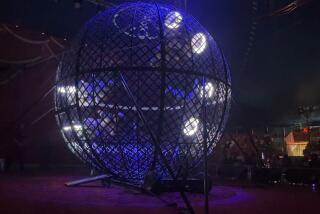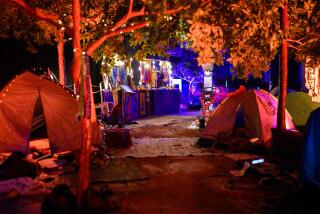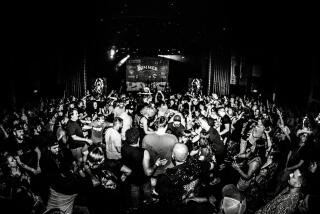POP MUSIC : The Day the Music Got Stomped : The Rolling Stones’ concert at Altamont was envisioned as a perfect close to the ‘60s. But bad planning, bad drugs and a violent death made for a concert nobody wants to remember.
It was supposed to be the West Coast’s answer to Woodstock--a free, unfettered music festival in San Francisco’s Golden Gate Park. Co-sponsored by the Rolling Stones and the Grateful Dead, the event was envisioned as a perfect way to sing goodby to the ‘60s.
But when the relocated concert took place at the Altamont Speedway east of the city on Dec. 6, 1969, it quickly sank into the annals of rock history as a colossal disaster.
Twenty-five years later, the legend of Woodstock is brighter than ever, and people flocked back to a repeat festival this August to try to relive some of the magic.
Nobody’s talking about Altamont ’94.
Parking, sanitation and medical facilities were grossly inadequate when the speedway crowd swelled to 300,000. Most of those people were cold, uncomfortable and unable to see the stage. Bad acid made the day even more hellish for many.
And late in the evening, as the Rolling Stones finished playing “Under My Thumb,” a young man named Meredith Hunter, 18, was stabbed and beaten to death in front of the stage.
Many of the principals involved in Altamont, including members of the two sponsoring bands, refuse now to even discuss the event. Others, however, are willing to look back--and the memories remain unsettling.
“It was the ultimate nightmare,” recalls Chris Hillman, a founding member of the Byrds who played at Altamont with the Flying Burrito Brothers. “It was the other end of the scale of what happened at Woodstock and at Monterey Pop--the dark side of the experience. There wasn’t anything redeeming about it, and it should never have happened. I was scared to death the whole time I was there.”
Stephen Stills, who performed at both Altamont and Woodstock as a member of Crosby, Stills, Nash & Young, agrees.
“We’d rather have people forget we were at Altamont,” he says now. “We played half a set and got out of there fast--like scalded cats. I had my guitar in one hand and Neil Young’s wife in the other because Neil had two guitars. We just ran to the helicopters, because it was obvious that something bad was going to happen.”
*
The Rolling Stones wanted to end their U.S. tour that year with a great day--a free concert in the park. Working with the Grateful Dead, they assembled a concert bill that included the Burrito Brothers, the Jefferson Airplane, CSNY and Santana.
At a tour press conference, Mick Jagger announced that the show would be “creating a sort of microcosmic society which sets an example to the rest of America as to how one can behave in large gatherings.”
But preparations for the show only began a month before it was supposed to happen. It became clear that Golden Gate Park would not be usable, and the week of the show, preparations were finally made to have the concert at the Sears Point Raceway near Novato, north of San Francisco.
Stage construction was almost completed when those plans fell through. Rather than call off the show, the Rolling Stones turned to well-known San Francisco lawyer Melvin Belli. Though he didn’t have any experience with rock festivals, Belli agreed to help the Stones find a site.
“They came up to my office and asked if there was anything I could do,” Belli remembers. “I got busy on the phone and called the mayor and the chief of police and everybody else around town. Finally, I got them the piece of property in the Altamont Pass. As we were pulling it together it seemed to be quite orderly. I thought it was going to be proper.
“I was negligent in not getting insurance for the property, because the landowner got sued by quite a few people. It was a wild experience. I don’t remember if I charged the Stones anything or not, but I know I enjoyed working with them.”
As the ill-fated show day dawned, the hastily transported stage, lights and sound system were still being reconstructed at the speedway. Some of the players had a sense of dread about the concert before even getting to the site.
“It was a wet, gray morning, and I’ll never forget thinking, ‘This feels like a weird day,’ ” says Hillman. “The Flying Burrito Brothers had been asked to play because Gram Parsons was tagging along a lot with Mick and Keith (Richards) back then. We jumped at the chance to be a part of it. But it was a bad day from the start.
“We got into a car accident on the way over. Then we had to park a mile away from the stage and carry our instruments through the crowd, which was scary. When we finally got backstage it was total chaos. No order at all. You’d always hear hectic talk backstage at any big show or festival, but this was nonstop horror stories.”
Chaos had been a part of the Woodstock festival a few months before Altamont--there had even been accidental deaths there. But the New York state festival was immediately celebrated as a triumph of good vibes. Yasgur’s farm was a place where a crowd of strangers had come together as a community, and where craziness and confusion had been transmuted into Aquarian ideals of peace, love and harmony.
At Altamont, the confusion repeatedly erupted into violence. Through a still murkily understood arrangement, local chapters of the Hells Angels motorcycle club had been pressed into service as a security presence, and were promised a quantity of beer in exchange for guarding the stage area.
The Angels were a familiar, non-threatening presence at Bay Area rock shows. But at Altamont, the bikers did not mix well with the loose, high-spirited crowd, and their attempts at establishing order in the midst of the tumult frequently took the form of violent beatings. “I’m not a peace freak,” Sonny Barger of the Hells Angels told a KSAN radio reporter after the show. “Some of these flower children were loaded up on drugs . . . and they came running, and yelling, and jumping on people. When they jumped on an Angel, they got hurt.”
“I didn’t think anything of the Hells Angels doing security, because I didn’t know that’s what they were there for,” says Marty Balin, who sang with Jefferson Airplane at the speedway.
“I’d always seen them at Avalon and Fillmore shows, and there was never any trouble. But when we were playing, I saw these guys hitting people with pool cues right in front of the stage. I thought somebody should be doing something, so I jumped down and tried to break things up. The Angels were a little surprised. One of them said, ‘Marty, what are you doing down here? You’re gonna get hurt.’
“The fighting stopped for a little while, and I started singing again. But then another fight broke out toward the back of the stage. I was trying to break that up when somebody hit me from behind and knocked me out. I don’t remember too much after that except being glad to be on the helicopter getting out of there. There wasn’t any other show I ever played that was as intense as that in such a negative way. It was just one real bad day.”
In retrospect, Dallas Taylor, who played drums with Crosby, Stills, Nash & Young at Altamont, is surprised that more people weren’t killed.
“We were expecting Woodstock West, but it was exactly the opposite of Woodstock,” he says. “Woodstock had a positive feel to it, and people decided to help each other out. Altamont had the feeling of fear and impending doom.
“From the moment we got there it was scary, and we felt lucky to get out of there with our lives. It didn’t surprise me at all that someone had been killed there.”
The killing of Meredith Hunter can actually be seen in the film “Gimme Shelter,” a documentary of the ’69 Stones tour put together by filmmakers David and Albert Maysles. Gary Weis, perhaps best known for the short films he later contributed to “Saturday Night Live,” was one of “Gimme Shelter’s” many roving cameramen, though he didn’t stick around the speedway long enough to see what happened when the Stones played.
“It was the most frightening workday I’ve ever had,” Weis says. “I remember lying on the grass and shooting these people by the medical unit--which was like a pup tent--who were all on bad trips, just writhing on the ground. As nightfall came, the jostling started, and the bad vibes got worse. I heard the band on stage saying, ‘Take it easy,’ and that was it. I turned in my film and got out of there.”
So did the Grateful Dead, who made it out to the site but decided not to play when it was clear that the concert had gotten out of hand. The Stones, who were used to overflow audiences and who had pulled off a huge, peaceful free concert in London’s Hyde Park just prior to the U.S. tour, attempted to salvage the day. The band got through the dense crowd to the Altamont stage aided by a caravan of bikers.
Instead of settling down for the headlining act, the crowd became more violent. The Stones couldn’t get through “Sympathy for the Devil” before violence again brought the music to a halt, and Jagger was forced to plead with the crowd to “cool out.” They tried to continue, but events turned even uglier after “Under My Thumb.”
In brief, grisly footage from “Gimme Shelter,” Hunter is seen close to the front of the stage, and appears to be in an agitated state. He also seems to have a gun in his hand. A man who appears to be one of the Hells Angels wields a knife and pounces on Hunter. Hunter is then swarmed and beaten.
(Hells Angel member Alan David Passaro was eventually acquitted of murder charges. His attorneys successfully argued that although he stabbed Hunter twice, he did not inflict the fatal wound.)
As a founding member of the Oakland chapter of the Hells Angels, Barger was part of the Angels’ presence at Altamont. Barger is still an influential voice in the club, and is sometimes referred to by law enforcement officials as its national president, though the Hells Angels say they have no such titles in their organization.
Barger declined to be interviewed for this story, but in “Gimme Shelter” he is heard calling in to a radio program after the show. “I didn’t go there to police nothing,” he says. “I ain’t no cop. . . . Mick Jagger put it all on the Angels. He used us for dupes. We were suckers for that idiot. They told me that if I could sit on the edge of the stage so nobody would climb over me, I could drink beer until the show was over, and that’s what I went there to do.”
Memories of the Woodstock Nation have taken on an increasingly rosy glow over the past 25 years--culminating in this year’s hyped Woodstock ’94. But memories of the Altamont fiasco have only soured, and, understandably, no one who was on stage at the speedway wants to give that venue another try.
“I don’t think anybody would be interested in Altamont II,” says Balin. “Who would you play for--stompers, skinheads and parolees?”
“Altamont made Woodstock look like even more of a miracle,” says Taylor. “And Woodstock II was strange enough--I don’t want to go back to Altamont.”
“I looked at the Woodstock revival and thought, ‘Why?’ ” says Hillman. “But I also remember Gram Parsons and I laughing at the original Woodstock because we thought the whole peace and love hippie thing had died by ’68. I don’t think I’d be interested in Altamont II. The last festivals I’ve done have been country or bluegrass, where families are sitting quietly in their lawn chairs and it’s real orderly. That’s my speed now.”
There is one optimistic voice of dissent, however. Counselor Belli says he’s up for giving the speedway another shot.
“Hell yes, I’d do another one,” he says. “Very definitely. This time I think we could straighten it up a little. And this time I’d sure as hell take out some insurance.”
More to Read
The biggest entertainment stories
Get our big stories about Hollywood, film, television, music, arts, culture and more right in your inbox as soon as they publish.
You may occasionally receive promotional content from the Los Angeles Times.










